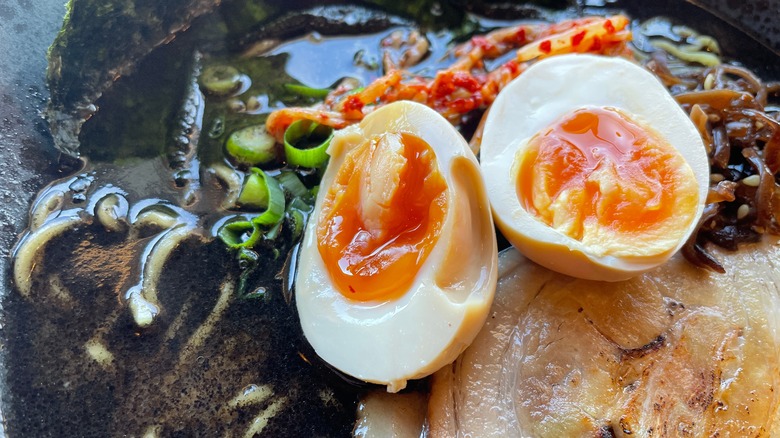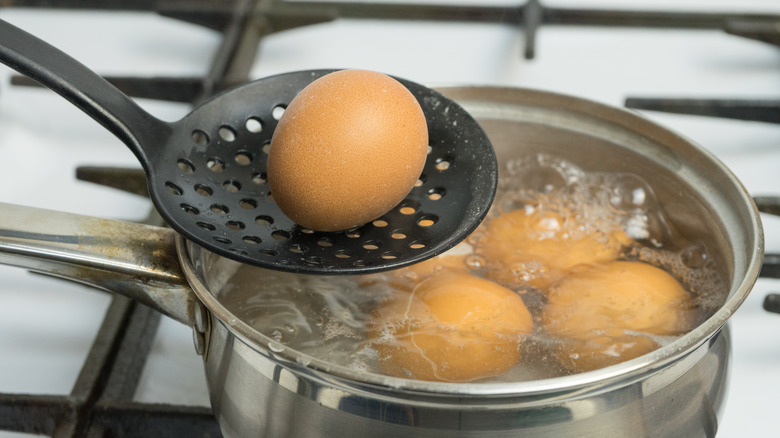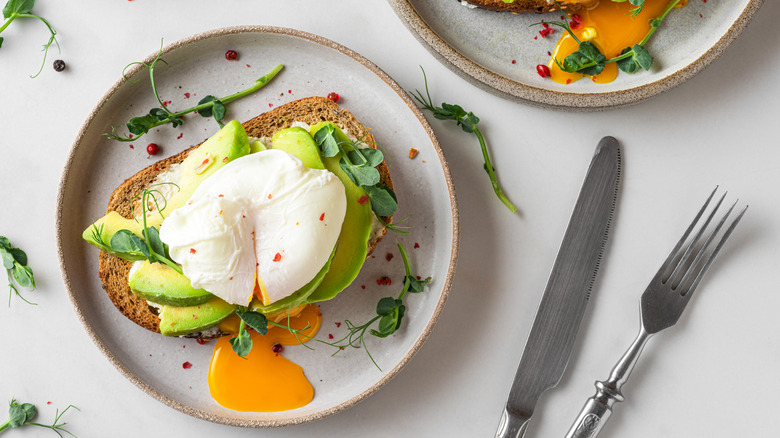A Quick Guide To Boiling Eggs For Golden, Jammy Yolks
Though omelets and frittatas cover the menu at nearly every breakfast restaurant in America, the U.S. is nowhere near the top when it comes to being the biggest consumers of the hearty source of protein. Actually, Japan eats the most eggs per capita, according to the World Population Review, which makes sense since they're often used as a topper on ramen bowls and other noodle dishes, which are a big part of the cuisine in the country.
No matter which way you like to enjoy eggs and no matter where you live, one of the most tempting ways to devour them is a soft-boiled preparation, which ensures a firm white outer layer and golden, jammy center that provides delectable texture to a number of dishes. But, there's a real art that comes with making soft-boiled eggs to ensure you'll get a perfectly tender inside every time — and it requires the right temperature, precise timing, and a flawless peeling strategy.
The correct cooking and peeling method for soft-boiled eggs
For the perfect soft-boiled egg that will produce that desired golden, jammy yolk, first you'll want to make sure the eggs you are using are at room temperature. So, if you normally store your eggs in the refrigerator, take them out around a half-hour before you plan to boil them. Otherwise, putting cold eggs straight into a hot pot will yield a rubbery and tough result. If you're in a rush and can't wait 30 minutes, place cold eggs in a bowl of warm water for about five minutes to help bring them to room temp.
Once your eggs are ready for the stove, bring a pot of water to boil, enough to cover the eggs by about an inch so that they can cook evenly. Take out the eggs after two to four minutes for a really runny center. If you like them to have more of a jammy yolk, keep them in the pot for about six (and no more than eight) minutes.
The hardest part comes when peeling them (it's so easy for pieces of egg white to come away with the shell). For a perfectly intact result, place boiled eggs in a bowl of ice water as soon as they come out of the hot water pot and leave them for at least five minutes. Next, take the smallest spoon you own and lightly crack just the bottom. Gently slide your spoon in between the shell and the main part of the egg, slowly working away the outer coating from the edible pieces.
Soft-boiled eggs are the star of so many dishes
A deliciously versatile ingredient, soft-boiled eggs with a slightly runny yolk fit perfectly with most any meal, from breakfast to dinner, and even be a go-to for a quick afternoon snack with a boost of protein.
This type of cooked egg makes a great addition to avocado toast in the morning, or soft-boiled eggs can be enjoyed on their own with a bit of salt sprinkled on top for something quick and easy. If you enjoy a heavier breakfast, try soft-boiled eggs atop a bowl of cheesy grits or a warm skillet that has a base of potatoes and veggies.
For lunch or dinner, soft-boiled eggs go great on a Cobb or nicoise salad where the slightly runny center can intermingle with the other garden-fresh ingredients on the plate. These cooked eggs also elevate a bowl of soup or soba noodles into something even more delicious, and gourmet hamburgers get a good deal of flavor with the added topper. A jammy yolk can also enhance a creamy and flavorful curry and tastes delightful as a topping that turns ramen into a restaurant-worthy bowl.



